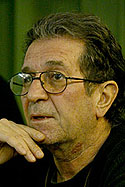Dariush Mehrjui made his debut in 1966 with Diamond 33. His second featured film, Gaav, brought him national and international recognition.[2] Gaav, a compelling symbolic drama, is about a simple villager and his nearly mythical attachment to his cow. The story of the film was from renowned Iranian literary figure Gholamhossein Sa’edi. The film's score was composed by musician Hormoz Farhat. [3] In 1971, the film was smuggled out of Iran and submitted to the Venice Film Festival where, without programming or subtitles, it became the largest event of that year’s festival.[4] The film was a turning point in the history of Iranian cinema. The public received it with great enthusiasm, despite the fact that it had ignored all the traditional elements of box office attraction. Several of Iran's prominent actors (Ezatolah Entezami, Ali Nassirian, Jamshid Mashayekhi, and Jafar Vali) played roles in the film.[5]
In 1973 Mehrjui began directing what was to be his most acclaimed film. The Cycle was co-sponsored by the Ministry of Culture but encountered opposition from the Iranian medical establishment and was banned from release until 1977.[3] It was universally admired abroad.[citation needed] The film won the Fédération Internationale de la Presse Cinématographique Prize at the Berlin Film Festival in 1978.[6] During this same time, Mehrjui found himself unable to work in Iran. He sojourned in California for a while before returning to Iran after the Iranian revolution. Mehrjui then directed The Backyard (1980). In 1981, he traveled to Paris and remained there for several years, during which he made a feature-length semi-documentary for French TV, Voyage au Pays de Rimbaud (1983). Feeling homesick, he returned to Tehran in 1985.
In Hamoun (1990), a portrait of an intellectual whose life is falling apart, Mehrjui sought to depict his generation's post-revolutionary turn from politics to mysticism. Hamoon was voted the best Iranian film ever by readers and contributors to the Iranian journal Film Monthly.[7]
In 1995, Mehrjui made Pari, an unauthorized loose film adaptation of J. D. Salinger's book Franny and Zooey. Though the film could be distributed legally in Iran since the country has no official copyright relations with the United States,[8] Salinger had his lawyers block a planned screening of the film at Lincoln Center in 1998.[9] Mehrjui called Salinger's action "bewildering," explaining that he saw his film as "a kind of cultural exchange."[9] His follow-up film, 1997's Leila, is a melodrama about an urban, upper-middle-class couple who learn that the wife is unable to bear childrenIn 1995, Mehrjui made Pari, an unauthorized loose film adaptation of J. D. Salinger's book Franny and Zooey. Though the film could be distributed legally in Iran since the country has no official copyright relations with the United States,[8] Salinger had his lawyers block a planned screening of the film at Lincoln Center in 1998.[9] Mehrjui called Salinger's action "bewildering," explaining that he saw his film as "a kind of cultural exchange."[9] His follow-up film, 1997's Leila, is a melodrama about an urban, upper-middle-class couple who learn that the wife is unable to bear children

 Dariush
Mehrjuei
Dariush
Mehrjuei